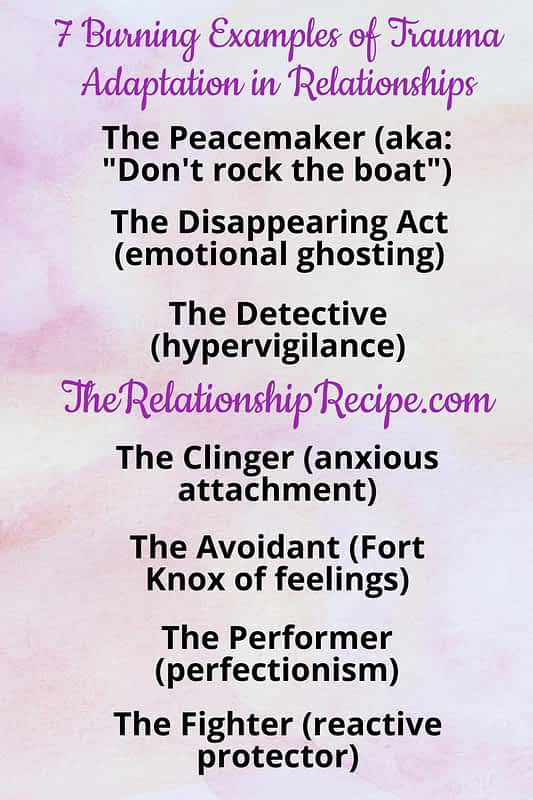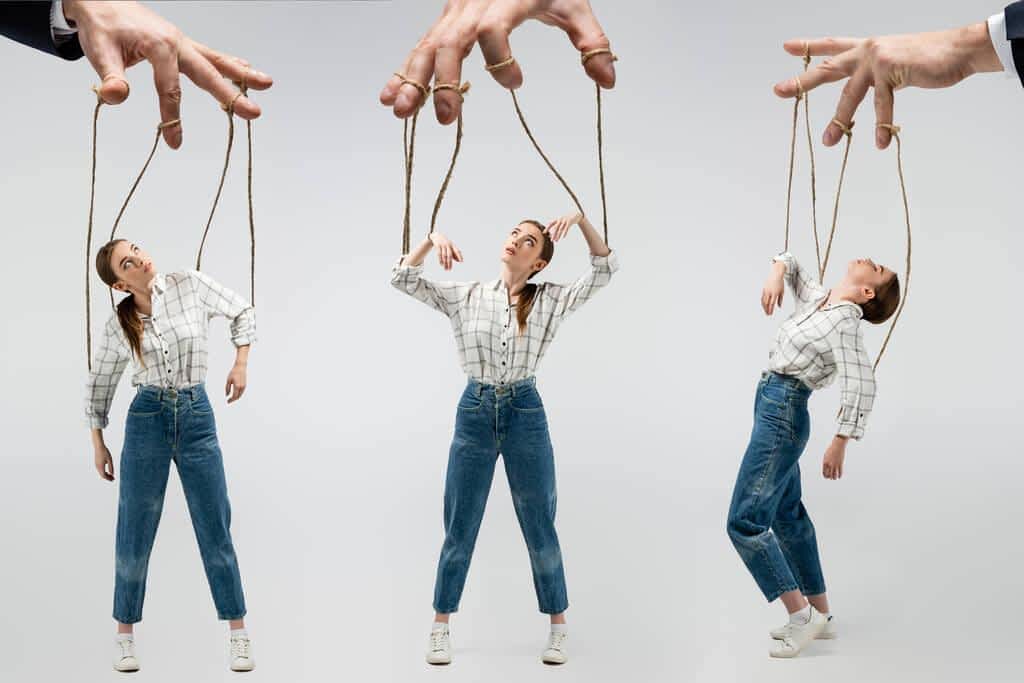7 Burning Examples of Trauma Adaptation in Relationships
Trauma adaptation in relationships is the survival dance you never signed up for but somehow learned by heart.
It’s the set of reflexes you picked up, usually without realizing, because old emotional injuries taught you certain behaviors or beliefs you had to adopt just to stay safe. Whether the damage came from your childhood or the ghosts of past relationships, these adaptations shape how you show up in love, in conflict, and in the day-to-day mess of sharing your life with another human.
If you’ve ever wondered how trauma shows up in relationships, look no further than the little habits you can’t seem to shake. The overthinking. The catastrophizing. The patterns that feel too familiar to be random. All that emotional baggage in relationships doesn’t just appear out of nowhere. It’s a survival strategy; one that can become your worst enemy when you’re trying to build something healthy.

🔑Key Highlights: Trauma Adaptation in Relationships
- Why some lovers vanish emotionally while others text like it’s a heartbeat monitor.
- The quiet war between needing love and fearing it.
- How past survival tactics secretly run your current relationship playbook.
- The fascinating push-pull dance between clingy hearts and closed-off souls.
- What lies beneath the performance of perfection, and why it never feels like enough.

Why We Use Trauma Adaptation in Relationships
🚩If someone learned early on that love = unpredictability, they might become hypervigilant in relationships and always scanning for danger.
🚩If someone experienced neglect, they might adapt by people-pleasing or disappearing emotionally to avoid feeling unwanted.
🚩Some might become avoidant. Others clingy. Some swing like emotional pendulums.
🚩Some stop trusting. Some over-trust. It’s all about what once helped them survive.
🚀It’s not “bad” or “broken”—it’s just outdated armor.
But if left unexamined,these signs of trauma adaptation can hijack intimacy, sabotage communication, and create patterns that feel like fate … but are actually just unhealed hurt.
These are just archetypes, because everyone’s dance is unique. Sometimes people carry multiple adaptations.
And the wild part?
Many of these behaviors worked brilliantly once. They were armor. Now, in safe love, they can become chains.

7 Examples of Trauma Adaptation in Relationships
Here are some real-world, heart-shaped, sometimes messy examples of how trauma shows up in relationships: Let’s unpack this suitcase of patterns we didn’t even know we packed.
💔The Peacemaker (aka: “Don’t rock the boat”)
Trauma Adaptation: People-pleasing, avoiding conflict, always putting others first.
Root: Grew up in chaos or unpredictability, and learned that keeping everyone happy = staying safe.
Let’s dive into a vivid scene of how emotional baggage in relationships shows up straight from the diary of a Peacemaker: also known as the “I’m fine, everything’s fine, as long as you’re fine” specialist.
🎬 SCENE: A cozy living room, evening light, the couple is sitting on the couch.
Partner:
“I really wish you had told me how stressed you were about work. I feel like you keep things from me.”
Peacemaker (with a smile too tight):
“Oh, it wasn’t a big deal! I didn’t want to bother you with it—you’ve had enough on your plate.”
Partner:
“But I want to be there for you. I don’t need you to protect me from your feelings.”
Peacemaker (internally panicking but smiling harder):
“No, really, it’s okay! I’m used to handling things on my own. Let’s just relax. Want to watch something?”
🎭 What’s happening here?
The Peacemaker adapts by minimizing their own needs and emotions to avoid conflict, rejection, or emotional overwhelm. Maybe growing up, their feelings were met with punishment, indifference, or caused tension, so they learned to suppress themselves to keep the peace and earn love.
How it backfires:
Eventually, resentment brews. They might feel unseen, unloved, or emotionally distant, but never voice it. Their partner might feel confused or shut out.
✔️It becomes a relationship where peace is present, but intimacy is absent.

💔 The Disappearing Act (emotional ghosting)
Trauma Adaptation: Withdrawing, going cold, shutting down during conflict or intimacy.
Root: Maybe had caregivers who were controlling, overwhelming, critical, or emotionally unavailable. Learned it’s safer not to feel.
The Disappearing Act—not to be confused with David Blaine. This is the emotionally ghosting type, the magician of vanishing intimacy.
🎬 SCENE: Kitchen, late night. Dishes half-done. The couple just had a slightly tense but normal disagreement about how much time they spend together.
Partner:
“I just miss you. Sometimes I feel like you’re physically here but emotionally checked out.”
The Disappearing Act (arms crossed, eyes a bit distant):
“…I don’t know what you want from me. I told you I’ve been tired. Work’s been crazy.”
Partner:
“I’m not blaming you. I just want to feel connected.”
The Disappearing Act (voice flat):
“Okay. I need to go for a walk.”
(leaves the house without another word, disappears for hours or goes silent for days, maybe buries themselves in work, screens, or distractions)
🎭What’s really going on?
The person bringing the emotional baggage in relationships might appear cold or avoidant, but it’s not that they don’t feel: it’s that feelings are terrifying.
Often, they learned growing up that vulnerability = danger. Maybe emotions were ignored, mocked, punished, or too overwhelming to cope with. So when intimacy feels close… they eject.
They don’t disappear because they don’t care.
They disappear because caring hurts and closeness feels unsafe.
😢 But what does the partner experience?
Confusion. Loneliness. Feeling like they’re loving a ghost.
This truama adaptation in relationships can create cycles of pursuit and withdrawal, where the more one partner chases, the more the other retreats.

💔The Detective (hypervigilance)
Trauma Adaptation: Overanalyzing every text, tone, or look. Constant worry partner is angry or leaving.
Root: Lived in environments where danger or rejection came without warning—now scanning for “signs” constantly.
Now we step into the world of The Detective, the hypervigilant partner, the Sherlock Holmes of relationships, except instead of hunting criminals, they’re tracking emotional shifts, tone changes, and text response times like their life depends on it.
🎬 SCENE: A sunny afternoon, texting back and forth. The Detective just sent a long message about their weekend. Partner replies with: “Cool, sounds fun :)”
The Detective (reading it 6 times):
“…Why just a smiley? Are they mad? Bored? Distant? That’s not how they usually text.”
(They scroll back through old messages. Compare emojis. Contemplate tone. Maybe call a friend:)
The Detective (on the phone):
“They always use two emojis, and now just a smiley?? And no exclamation point. Something’s wrong. I knew I was being too much yesterday…”
(Sends a follow-up text an hour later:)
“Hey, did I say something weird? You seem kinda off.”
🎭What’s really going on?
This person’s trauma adaptation is hyper-awareness of emotional cues—because once upon a time, not noticing the subtle shift in a parent or partner’s mood could’ve meant punishment, abandonment, or emotional shutdown.
They learned:
“If I can sense the danger before it hits, I can protect myself.”
But in healthy relationships, this becomes a self-sabotaging loop.
They decode things that were never encoded. They chase reassurance like oxygen. They feel unsafe unless they’re sure they’re safe.
😭 And what about the partner?
To a partner living with signs of trauma adaptation in the relationship may feel micromanaged, accused, or like they can’t relax. Even neutral actions feel like minefields.

💔The Clinger (anxious attachment)
Trauma Adaptation: Needs constant reassurance, fears abandonment, may rush closeness.
Root: Inconsistent caregivers, sometimes loving, sometimes not, led to uncertainty around love and worth. It’s one of the most deeply rooted signs of trauma adaptation.
The Clinger (a.k.a. anxious attachment, but make it fashionably frantic).
They don’t want love, they need it. Crave it. Text-you-back-in-14-seconds love.
If love was a plant, they’d water it every 10 minutes until it drowns.
Let’s dramatize it:
🎬 SCENE: It’s been 2 hours since their partner said “I’ll call you after work.”
The Clinger (pacing, checking phone, sighing):
“They said after work. It’s 6:13. They’re definitely ignoring me. Maybe they changed their mind. Maybe they met someone new. Should I call? No. Yes. No.”
(Texts: “Hey! Everything okay?” …Then, “Just checking in <3” …Then, “Are you mad?”)
Partner (finally calls at 6:30):
“Hey babe, sorry! Got stuck on a call with my boss—what’s up?”
The Clinger (trying to act chill but voice shaky):
“Oh, no worries! I wasn’t worried or anything… just… you know. Missed you.”
(Hangs up and feels temporary relief… until the next time love feels slightly out of reach.)
🎭What’s going on here?
The Clinger’s emotional baggage in relationships is how trauma shows up in relationships with is this aching need for closeness, certainty, and connection.
Likely grew up with inconsistent caregiving where sometimes love showed up, sometimes it didn’t. So now, their nervous system is on HIGH alert for rejection or abandonment.
They confuse proximity with security.
“Are you near me? Talking to me? Texting me back? Good. I’m safe… for now.”
🧨 But what happens in the relationship?
Their partner can feel smothered, like there’s no space to breathe without triggering a mini emotional alarm.
Ironically, the more The Clinger clings, the more some partners pull away—and the very fear they’re trying to prevent becomes a reality.

💔The Avoidant (Fort Knox of feelings)
Trauma Adaptation: Keeps relationships at a distance, avoids deep emotional vulnerability.
Root: Often didn’t feel emotionally safe growing up, so learned independence = survival. This can be one of the most confusing signs of trauma adaptation because of the constant push and pull it brings to the relationship,
Now entering the emotional fortress:
Feelings? Vulnerability? Letting someone in?
Try again. This is lockdown mode, baby.
Here we go:
🎬 SCENE: A sweet moment. The partner says: “I love you.” They’re gazing. Vulnerable. Hoping.
The Avoidant (suddenly very interested in the ceiling):
“…Thanks.”
Partner (confused, hurt):
“That’s it?”
The Avoidant (shrugging, tone casual):
“Yeah, I just don’t really say stuff like that. You know how I am.”
(They grab their phone. Scroll. Joke. Deflect. Exit emotional conversation stage left.)
Later, when the partner expresses hurt:
The Avoidant:
“You’re too sensitive. Why does everything have to be so intense?”
🎭What’s happening behind that chill exterior?
Avoidants often grew up witnesing how trauma shows up in relationships caused by emotional neglect or environments where vulnerability = weakness. They learned to rely on themselves, and themselves only.
Their trauma adaptation is to guard their feelings like treasure. Getting too close? That’s a risk. Depending on someone? A trap. Needing someone? A liability. So when love starts to feel real…
They don’t run because they don’t care.
They run because it’s safer not to care.
🔁 And the kicker?
They often attract Clingers. Yup.
One wants closeness like air; the other treats closeness like a panic attack.
It’s the chase-dodge cycle of doom. 😱

💔The Performer (perfectionism)
Trauma Adaptation: Always trying to be “enough” by doing, achieving, fixing.
Root: Felt love was conditional—based on success, helpfulness, or being “easy to love.”
Now taking center stage under the spotlight of how trauma shows up in relationships:
The Performer
(A.K.A. If I’m flawless, you’ll never leave me … or judge me… or see I’m scared underneath this curated masterpiece.)
Of the many signs of how trauma shows up in relationships, is that this one’s all about earning love by being impressive, helpful, low-maintenance, productive, or the most amazing partner you’ve ever had.
Let’s roll camera:
🎬 SCENE: A romantic dinner. Partner says, “You don’t have to try so hard, you know. I love you even when you’re not doing everything perfectly.”
The Performer (laughs, waving it off):
“Oh, I’m not trying that hard! Just wanted to make tonight special! I made your favorite three-course meal, ironed the tablecloth, and also deep-cleaned the house—because, why not?”
(sips wine, secretly panicking)
Partner (gently):
“I just want you. Not the effort. Not the presentation.”
The Performer (smiles, but there’s a flicker of discomfort):
“Right… but what if me isn’t enough?”
🎭What’s really going on?
The Performer learned early that love = achievement.
That being “good” = being wanted.
Maybe they were rewarded for accomplishments, not feelings. Maybe their needs were too much for someone growing up, so they became the “easy” one.
Now, in their signs of trauma adaption in relationships, they try to be exceptional so they won’t be abandoned, criticized, or rejected.
They don’t rest. They don’t show mess.
Because underneath? They fear that just being “normal” = unworthy.
😔 And how does this affect the relationship?
It creates a subtle disconnection. Their partner might feel like they’re in love with an image, not a person. Vulnerability feels like a performance, not a bond. And The Performer? They’re exhausted from constantly rehearsing for love that should’ve been theirs just for existing.

💔The Fighter (reactive protector)
Trauma Adaptation: Quick to anger, defensiveness, or control in response to feeling hurt or unsafe.
Root: Possibly had to fight to be heard, seen, or protected, and learned offense = best defense.
🔥(A.K.A. The Reactive Protector, a.k.a. “Come close and I’ll push you back before you even think about hurting me.”)
This is how trauma shows up in relationships with a fighter since they are one that doesn’t wait for rejection or betrayal. Oh no. They pre-reject you. They pre-fight the fight. They’re like love’s bodyguard, except they’re guarding themselves… from you.
Alright, lights, camera, emotional armor, action:
🎬 SCENE: A simple conversation. Partner says: “Hey, I felt kind of ignored last night when you were on your phone during dinner.”
The Fighter (instantly on high alert):
“Oh, so now I’m the bad guy? Maybe you should’ve said something instead of acting fine all night!”
Partner (startled):
“I’m not attacking you, I just wanted to talk about it…”
The Fighter (arms crossed, tone sharp):
“Right. It’s always my fault. You just love pointing out everything I do wrong, don’t you?”
(Storms off, heart racing, pride roaring, vulnerability buried.)
🎭What’s going on under the blast zone?
The emotional baggage in relationships with a Fighter is because they grew up having to defend their heart: maybe from criticism, chaos, betrayal, or neglect.
They learned: “If I don’t fight, I’ll get hurt. If I don’t defend, I’ll get destroyed.”
So when intimacy gets real, or someone expresses a need, or heaven forbid—criticism?
Their nervous system screams: DEFCON 1.
React first. Feel later. Vulnerability = danger. Attack = safety.
💣 But in the relationship?
It becomes a war zone. Their partner walks on eggshells. Emotional conversations turn into battles.
And The Fighter? They’re lonely in their armor. Safe, but starved for closeness.

Wrapping Up Trauma Adaptation in Relationships
Emotional baggage in relationships is rarely just about the now. It’s a patchwork of every goodbye, every ignored need, every moment we weren’t met how we needed to be.
Trauma adaptation in relationships are not flaws. They’re old survival codes written in childhood, refined in heartbreak, and unknowingly run on autopilot in adulthood.
Maybe you’re The Clinger, loving too hard out of fear.
Maybe you’re Fort Knox, holding back love to stay safe.
Or The Performer, hoping perfection will protect you.
Or The Detective, decoding texts like emotional Morse code.
Or even The Fighter, armored up so no one gets too close.
The key isn’t shame. It’s awareness.
Because what helped us survive… might now be what’s stopping us from truly connecting.

❓ FAQ: Trauma Adaptation in Relationships
1. What is trauma adaptation in relationships?
They’re the protective behaviors we develop from past emotional wounds, often without realizing it.
2. Is trauma adaptation the same as attachment styles?
They’re cousins! Adaptations often show how those attachment styles play out in real life.
3. Can someone have more than one truama adaptation?
Totally. People are emotional burritos—layers of different patterns and responses.
4. Is it possible to unlearn these behaviors?
Yup! With self-awareness, support, and a little inner excavation, you can rewire those patterns.
5. Does trauma adaptation mean I’m broken?
No way. They mean you survived. Now it’s just about shifting from survival to connection.
6. Why do I attract people with the opposite adaptation?
Opposites often activate each other’s wounds. It’s like a subconscious chemistry test.
7. How do I know if I’m The Clinger or just really loving?
Clingers fear abandonment even when things are fine. It’s love with anxiety baked in.
8. Is The Avoidant always cold-hearted?
Nope. They care deeply—it just feels safer not to show it.
9. Can a healthy relationship still have trauma adaptation?
Sure, but they need to be named, owned, and managed—not left to run the show.
10. What’s the first step to healing trauma adaptation?
Get curious, not critical. Name your patterns. Then ask: “What were they protecting me from?”

This post may contain affiliate links. I earn from qualifying Amazon purchases at no extra cost to you. This content is for informational purposes only and is not a substitute for professional advice. [Read full disclaimer.]
Thank you for reading this post, don't forget to subscribe!







